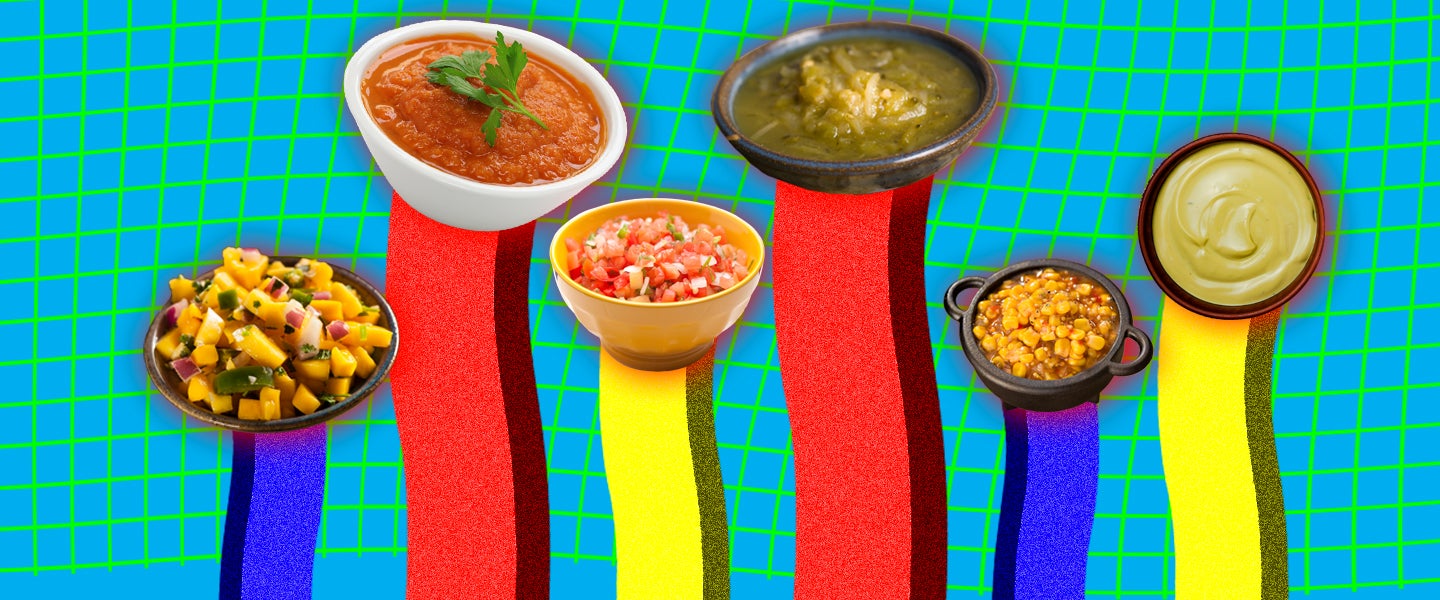For a taco truck aficionado like myself, unlimited salsa is a godsend. I need my tacos doused in a robust combination of salsas — red, green, minced and pureed — similar to how a beverage enthusiast might feel the urge to concoct a pungent suicide soda come time to fill their cup.
There are moments, though, as I stand there gawking at the numerous buckets of various salsas, when I question which will supply the healthiest fusion of fruits, vegetables and spices to the folded mass of meat, grease and carbs I’m about to ingest. So I asked Dana Hunnes, senior dietitian at the Ronald Reagan UCLA Medical Center, to help me rank a wide assortment of salsas by how healthy they are — from super sauce to somewhat healthy.
What was unexpected — especially considering the extensive range of colors, flavors and textures that salsas come in — was Hunnes telling me that pretty much all of them provide a relatively similar dose of healthiness. “They’re all healthy, and they’re hard to rank,” she claims. “There’s not a single one I wouldn’t suggest eating.”
For a second opinion, I reached out to clinical nutritionist Tara Coleman, who said pretty much the same thing. “I’m not really sure how to rank them from a health standpoint,” she emphasizes, adding that most salsas are “pretty comparable.”
While this definitely throws a hot chili in my ranking, the good news is, as far as nutrition is concerned, most every salsa is a good choice, because the ingredients used to make them are some of the absolute healthiest out there. “Salsas are either finely cut, minced or somewhat mashed fruits and vegetables,” Hunnes explains. “All of them are lowish in calories — except perhaps guacamole, which is still super-duper healthy — and healthy for you.” One serving of your average salsa is about two tablespoons, which is less than 10 calories on average.
For more proof of how healthy these taco toppers really are, here are some basic salsa facts. For starters, tomatoes, onions and lime juice — the three baseline ingredients usually used in salsa making — are some of the richest sources of vitamin C, which bolsters the immune system and promotes general good health as we age. One important note here: Vitamin C is easily destroyed when heated, but since salsas are often served raw, they typically provide high amounts.
Salsas and their hodgepodge of fruits and vegetables are also incredibly high in fiber, which helps the gastrointestinal system run smoothly and makes us feel satiated after eating, preventing us from going overboard with another seven tacos. Likewise, these fruits and vegetables — namely tomatoes, which apparently contain more water than watermelons — provide a whole lot in the way of hydration, a pillar of good health.
Speaking of tomatoes, these red (or green! Or yellow) bois contain a carotenoid called lycopene, which has been linked to reduced risk of heart disease and cancer. Quercetin, another type of antioxidant found in both onions and tomatoes, has also been found to have anticancer, anti-inflammatory and antihistamine effects. According to Coleman, both garlic and cilantro — two other staple salsa ingredients — provide similar antioxidant and anti-inflammatory properties. “Most of these benefits are preserved when we eat them raw,” she adds, “so salsa is a perfect delivery system.”
Meanwhile, the peppers used in salsa-making provide a nice dose of capsaicin, the ingredient responsible for their heat, which has been shown to boost metabolism, suppress appetite and promote general weight loss. Combine that with the incredibly low amount of calories in salsa, and you can essentially use as much as you want without worrying about your waistline. Coleman adds that consuming capsaicin releases endorphins, too, which “has a positive benefit on both physical and mental health.”
The point is, the ingredients most commonly used to make salsas are super healthy, and since the people who make fresh salsa often use different amounts and variations of these ingredients — perhaps even on a daily basis at food establishments like taco trucks — coming up with a realistic ranking is virtually impossible.
In fact, even some of the more outlandish salsas are incredibly healthy — arguably even more so than the more basic versions. “Adding flavor boosters, like corn, mango or avocado, does not take away the health benefits,” Coleman says. “In fact, it adds others.” Avocados, for instance, provide a nice dose of monounsaturated fats, which are particularly healthy, for several reasons: They help us lose weight, keep our heart healthy, reduce our chances of developing cancer and so on. Hunnes says mangoes are a good source of vitamin A, which is important for good vision, the immune system and reproduction. Corn, meanwhile, is rich in vitamin B12, which helps create DNA, keeps your nerves and blood cells healthy and prevents megaloblastic anemia, which makes people tired and weak.
Now, one thing I should mention is that store-bought salsas tend to sneak in a moderate amount of sodium, and sometimes sugar, too. But still, unless you were to chug the stuff straight from the jar, even the more processed salsas are pretty healthy and utilize a relatively minimal number of ingredients.
So to finish things off, while I do apologize for not being able to rank salsas like I have with many other foods, at least we can all rest easy knowing that no matter which ones we choose to flavor our foods with, we can chug a bathtub full of the stuff and still be okay.

